How to Connect WooCommerce with QuickBooks Online using PayTraQer ?
October 17, 2025
Before you get started
How to integrate WooCommerce with QuickBooks Online using SaasAnt PayTraQer
PayTraQer connects your WooCommerce store to QuickBooks Online. It syncs orders, refunds, fees, and payouts using your rules so your bank deposits match and your reports stay accurate.
Who this is for
Bookkeepers and accountants supporting WooCommerce stores
Store owners who are exporting CSVs and fixing numbers by hand
Teams comparing sync tools and looking for a safe first setup
Before you start
Active QuickBooks Online company
QuickBooks Online login with admin access
WooCommerce store admin login
Quick setup: 5-minute success path
In QuickBooks Online, open Apps or Integrations, search PayTraQer, click Get app now, and authorize.
Choose Sync Mode: Consolidated (summary) or Itemized (one entry per order). Click Get Started.
In PayTraQer, go to Connectors → eCommerce connectors → WooCommerce → Connect.
Log in to WooCommerce and click Approve to connect PayTraQer.
Set Bank Account to deposit your sales/income to WooCommerce Bank Account. Save.
PayTraQer downloads last 60 days history.
Use Download historical transactions for other periods and turn on Auto Sync to keep new orders flowing.
In QuickBooks, verify one sale, one fee, and if enabled, one payout.
What the sync does
Commerce system | QuickBooks entry created |
Payment | Sales Receipt, Fees as Expense |
Invoice Payment | Invoice, Payment or Sales Receipt, Fees as Expense |
Bank Payout | Bank Payout |
Customer Refund | Refund |
Expense | Expense |
Notes
Fees post as Expenses to your chosen fee account with vendor set to WooCommerce or the processor.
Bank Payouts post when payouts are enabled in settings.
Step-by-Step Guide to integrate WooCommerce with QuickBooks Online
1) Install PayTraQer from QuickBooks
In QuickBooks Online, open Apps or Integrations
Search PayTraQer and click Get app now
When the QuickBooks prompt appears, click Connect to allow access
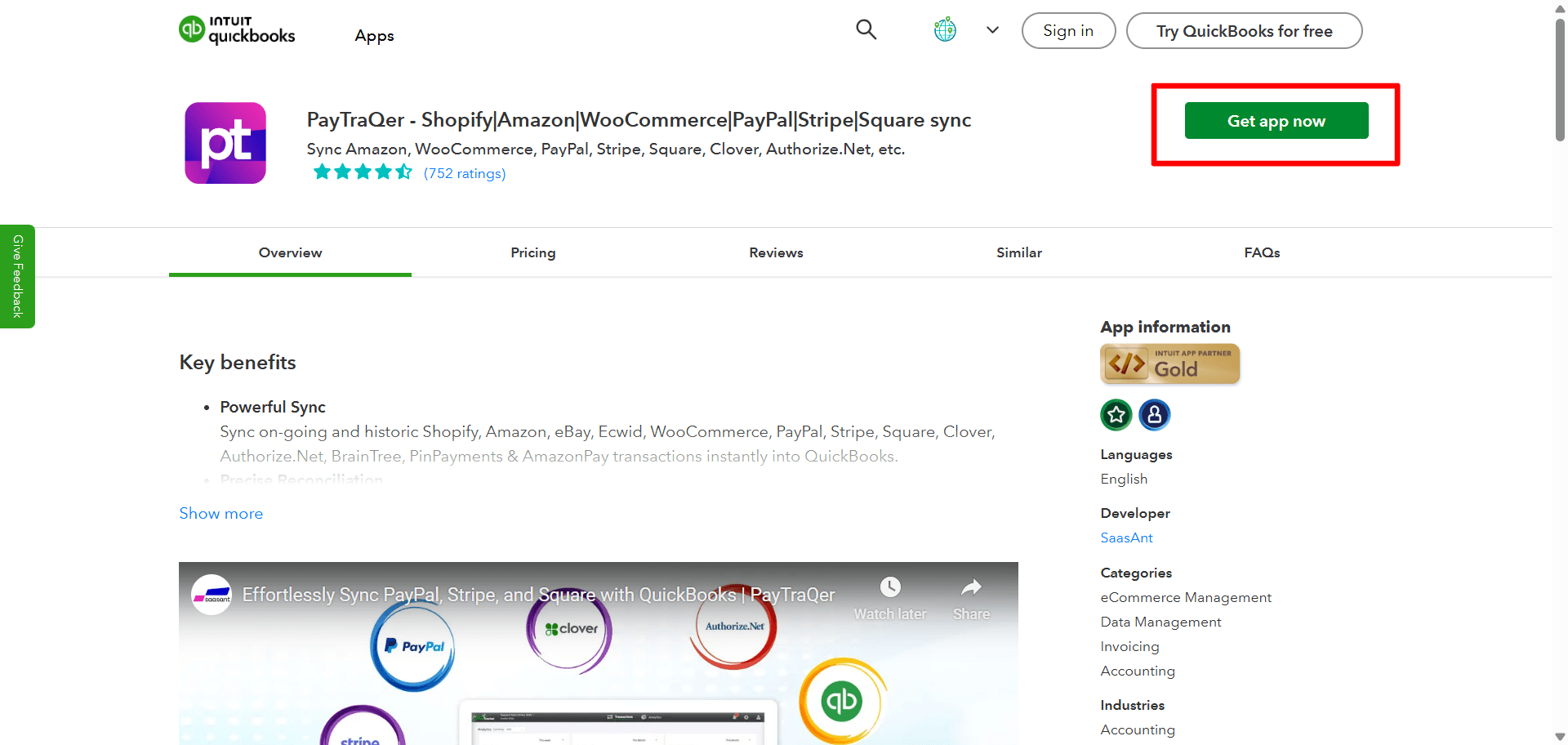
You can try PayTraQer with a free trial.
2) Pick your Sync Mode
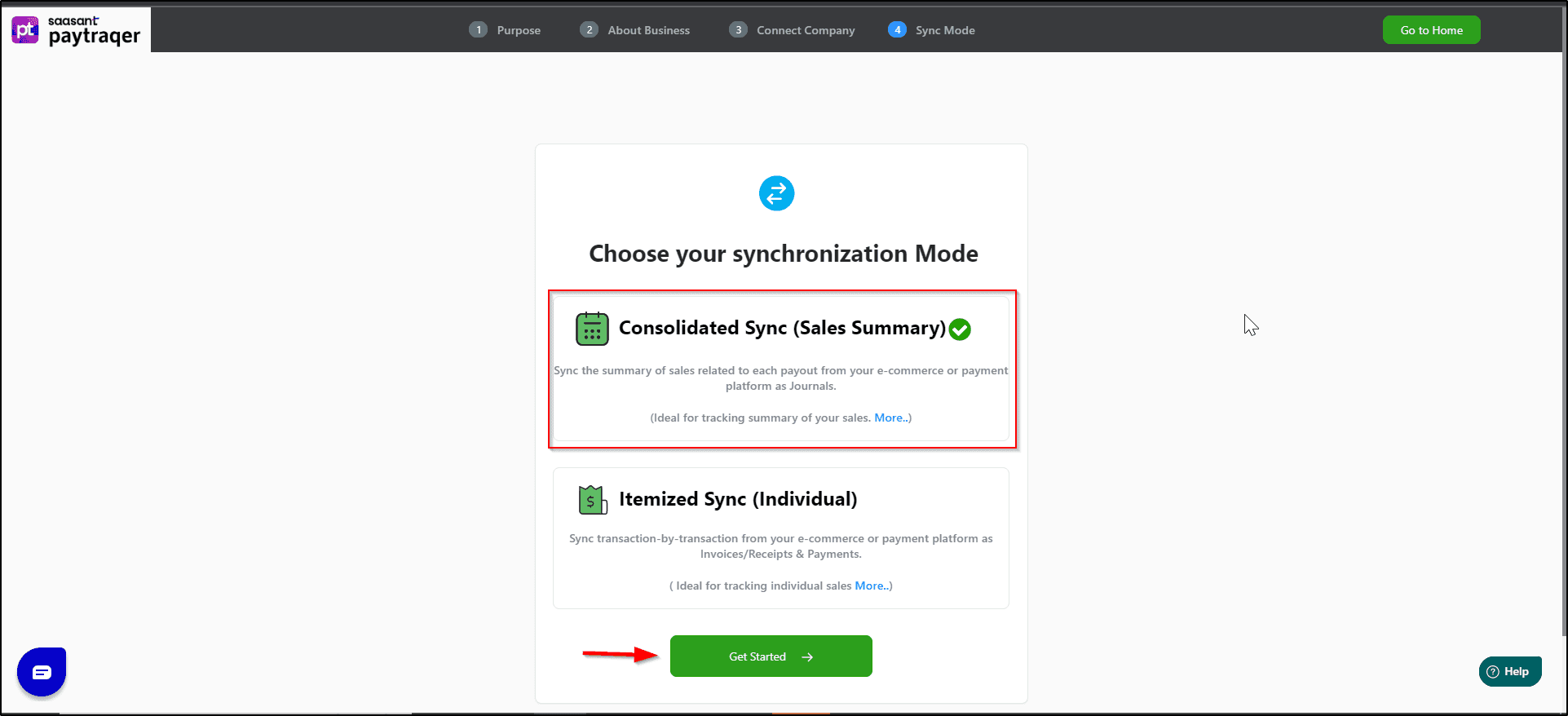
Choice | When to use | What you get |
Consolidated (Sales Summary) | High order volume, want fast bank match | Fewer entries by day or payout |
Itemized (Individual) | Need customer or item level reporting | One entry per order with full detail |
You can change this later in settings. Test a short date range before switching.
3) Connect WooCommerce
In PayTraQer, open Connectors → eCommerce connectors → WooCommerce → Connect

Log in with your WooCommerce admin account
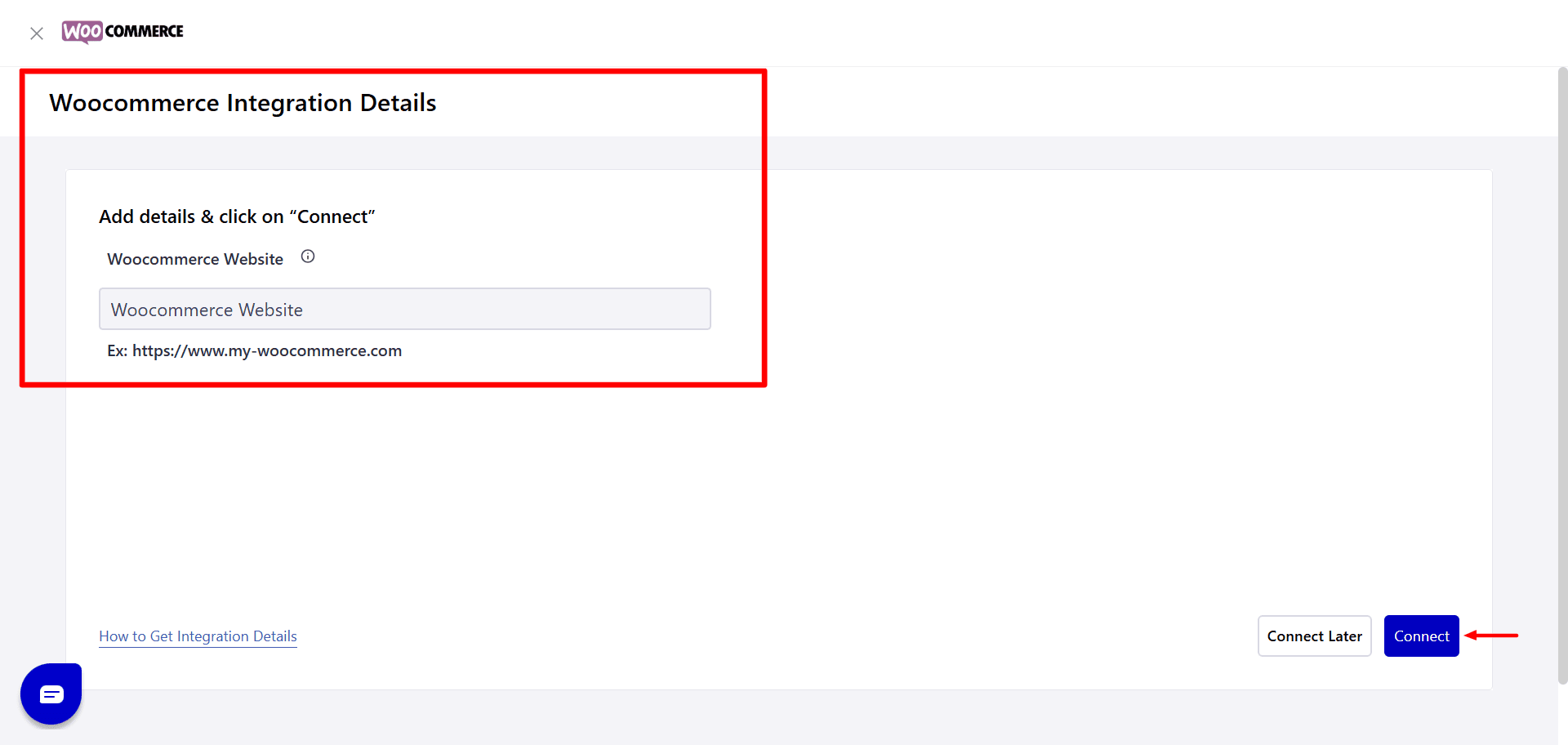
Review the access list and click Approve
Once approved, PayTraQer can read orders, customers, coupons, and products and sync them into QuickBooks.
If you are not an admin, you can generate the invite link.

4) First-time settings
After connect, review the main settings for WooCommerce
PayTraQer downloads last 60 days history.
Use Download historical transactions for other periods and turn on Auto Sync to keep new orders flowing.
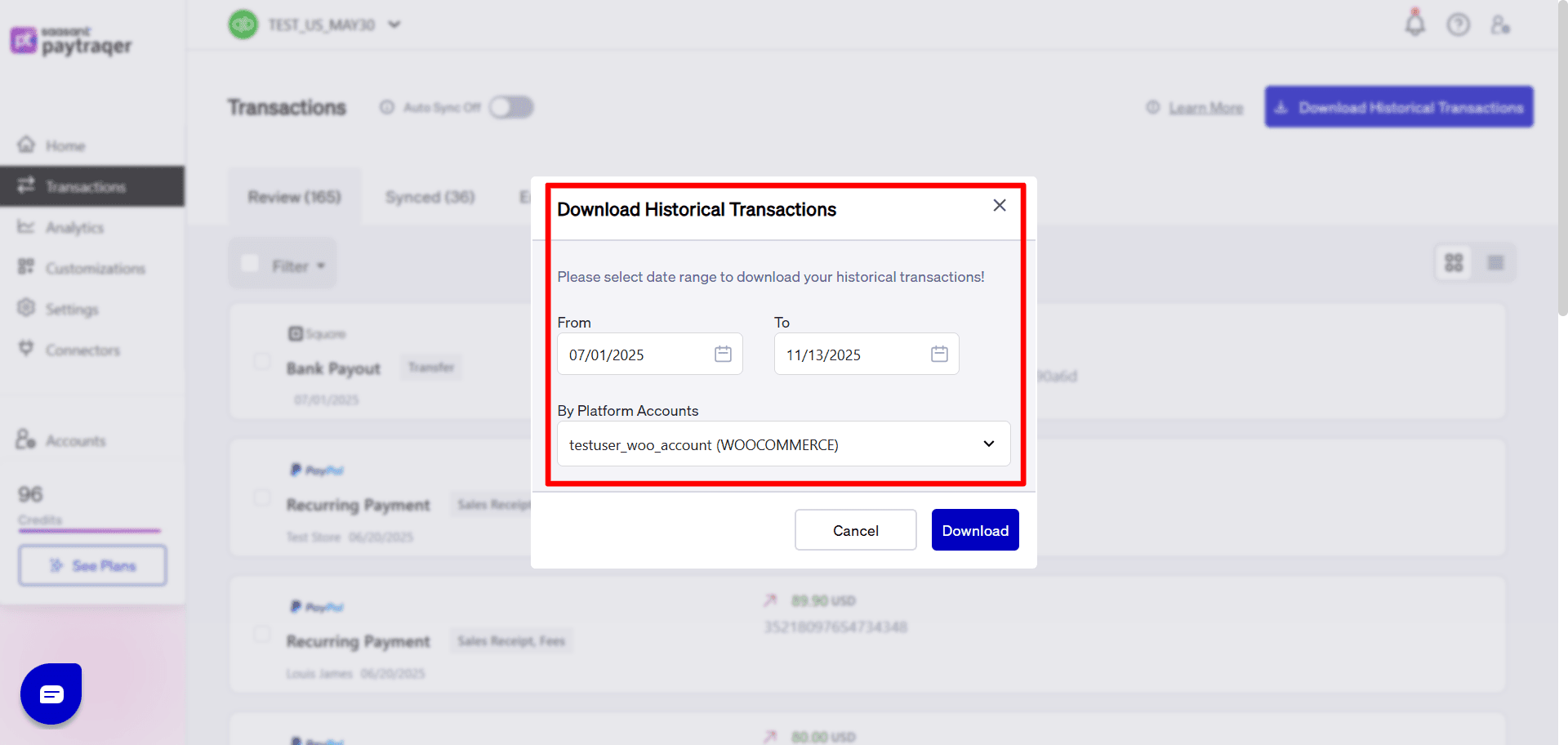
You can use Auto sync option to help automatically downloaded and synced to QuickBooks at regular time intervals
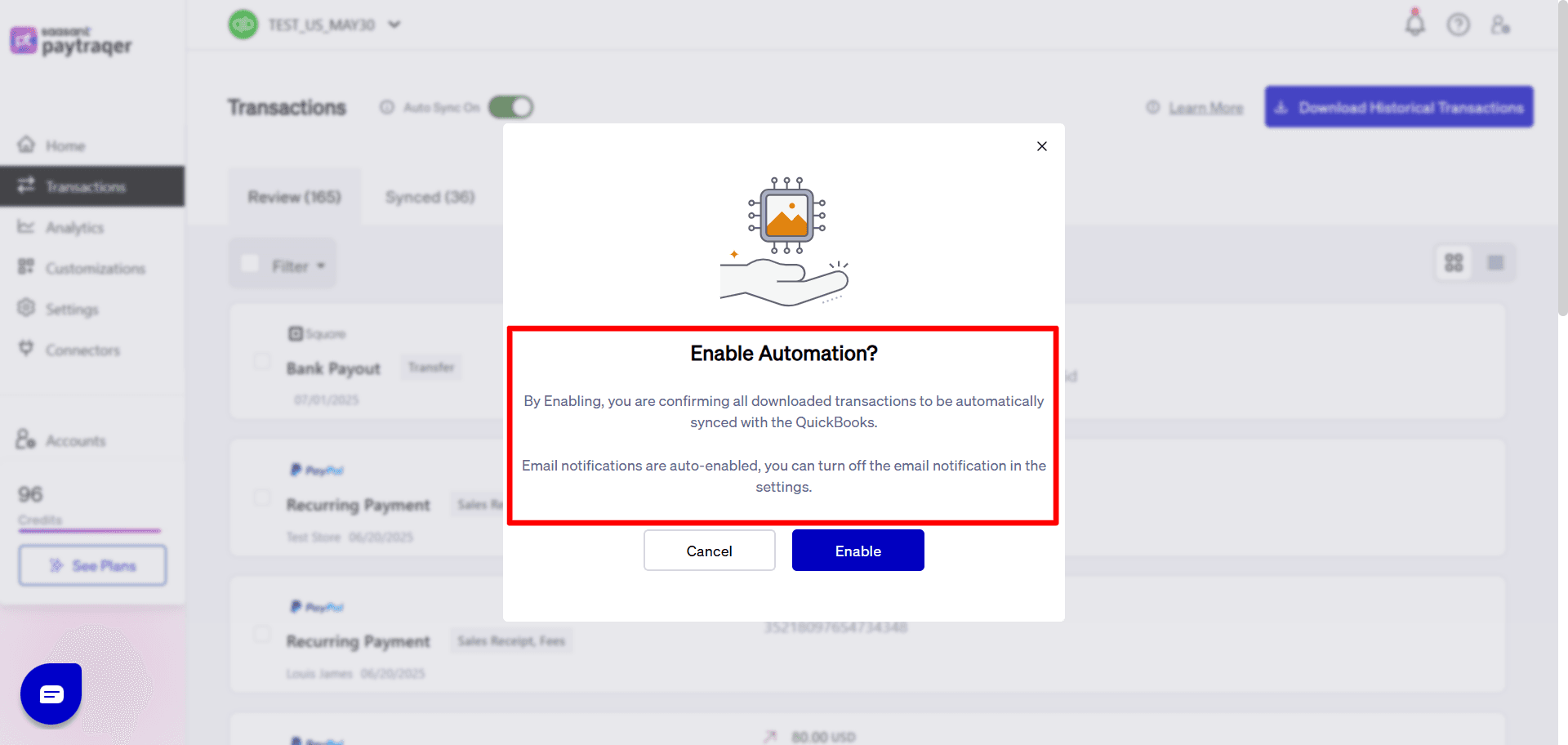
Sales settings
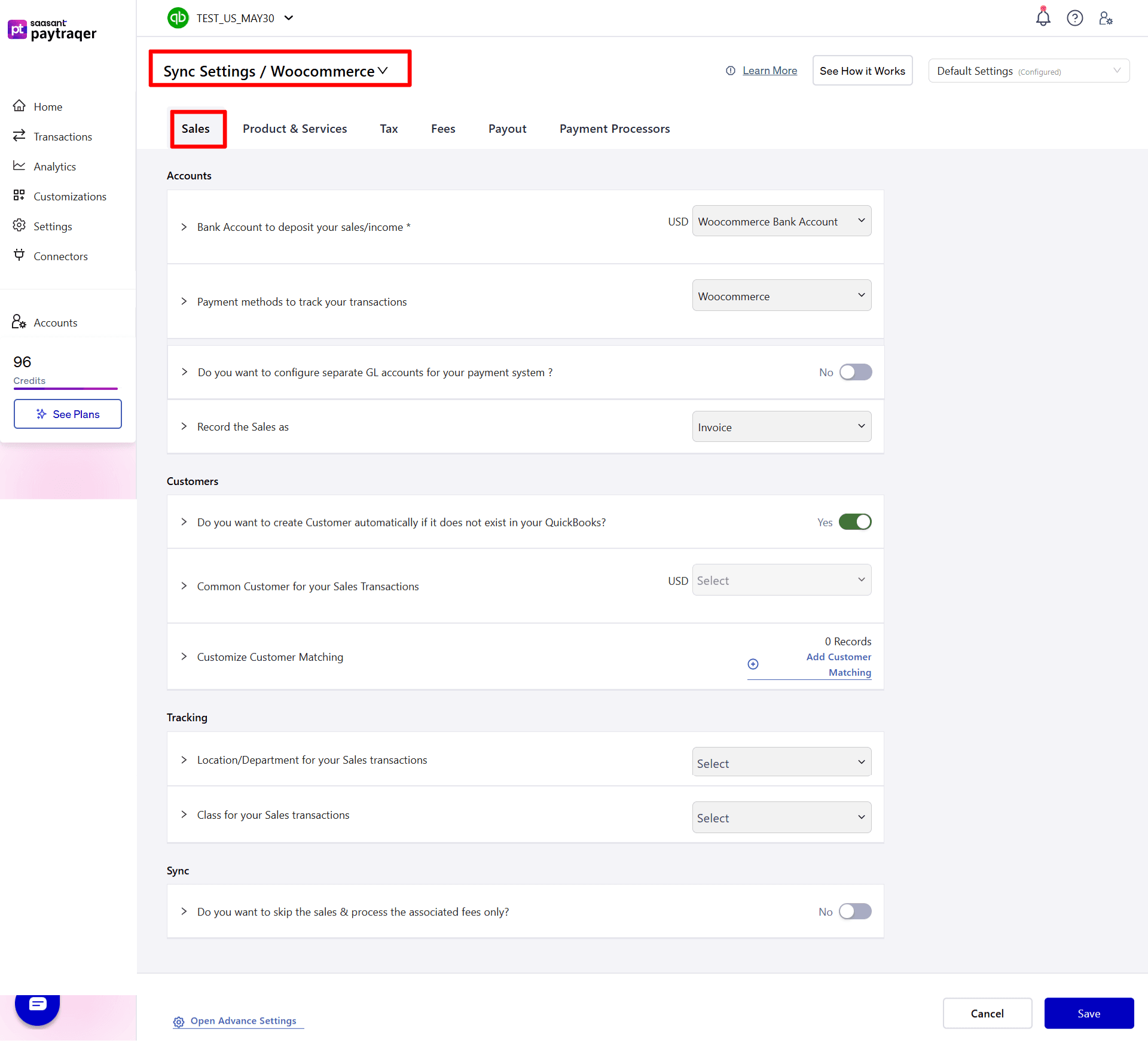
Accounts
Bank Account to deposit your sales/income
Set to WooCommerce Bank Account for each currency.
This is your clearing account where PayTraQer posts WooCommerce sales.
Payment methods to track your transactions
Default: WooCommerce.
Used as the Payment Method on the Sales Receipt or Payment in QuickBooks.
Configure separate GL accounts for your payment system
Currently: No in Sales.
Turn on only if you want different GL routes per payment connector and have linked them under Payment connectors.
Record the Sales as
Default here: Invoice.
Use Invoice if you bill and collect later.
Switch to Sales Receipt if you charge at checkout and want simpler posting.
Customers
Create Customer automatically if it does not exist: Yes
PayTraQer creates a new customer when there is no name match.
Common Customer for your Sales Transactions: Off by default
Turn on if you want to post summaries under one customer.
Customize Customer Matching
Add rules if WooCommerce names differ from your QuickBooks customer names.
Tracking
Location/Department and Class
Optional. Set them if you track store activity this way.
All synced sales will carry these values.
Sync scope
Skip the sales & process the associated fees only: No
Turn on only if another tool posts the sales and you only want fees.
Products and services settings

Create Products/Services automatically: Yes
Prevents missing item errors by creating items in QuickBooks.
Type for auto-created items: Non Inventory or Service
Income Account for auto-created items: Sales
Match Product by: Name
Switch to SKU if you maintain stable SKUs between WooCommerce and QuickBooks.
Customize Product Matching
Add rules when names differ between systems.
Common Item: Off by default
Turn on and select one product/service if you only need summary level posting.
Tax settings
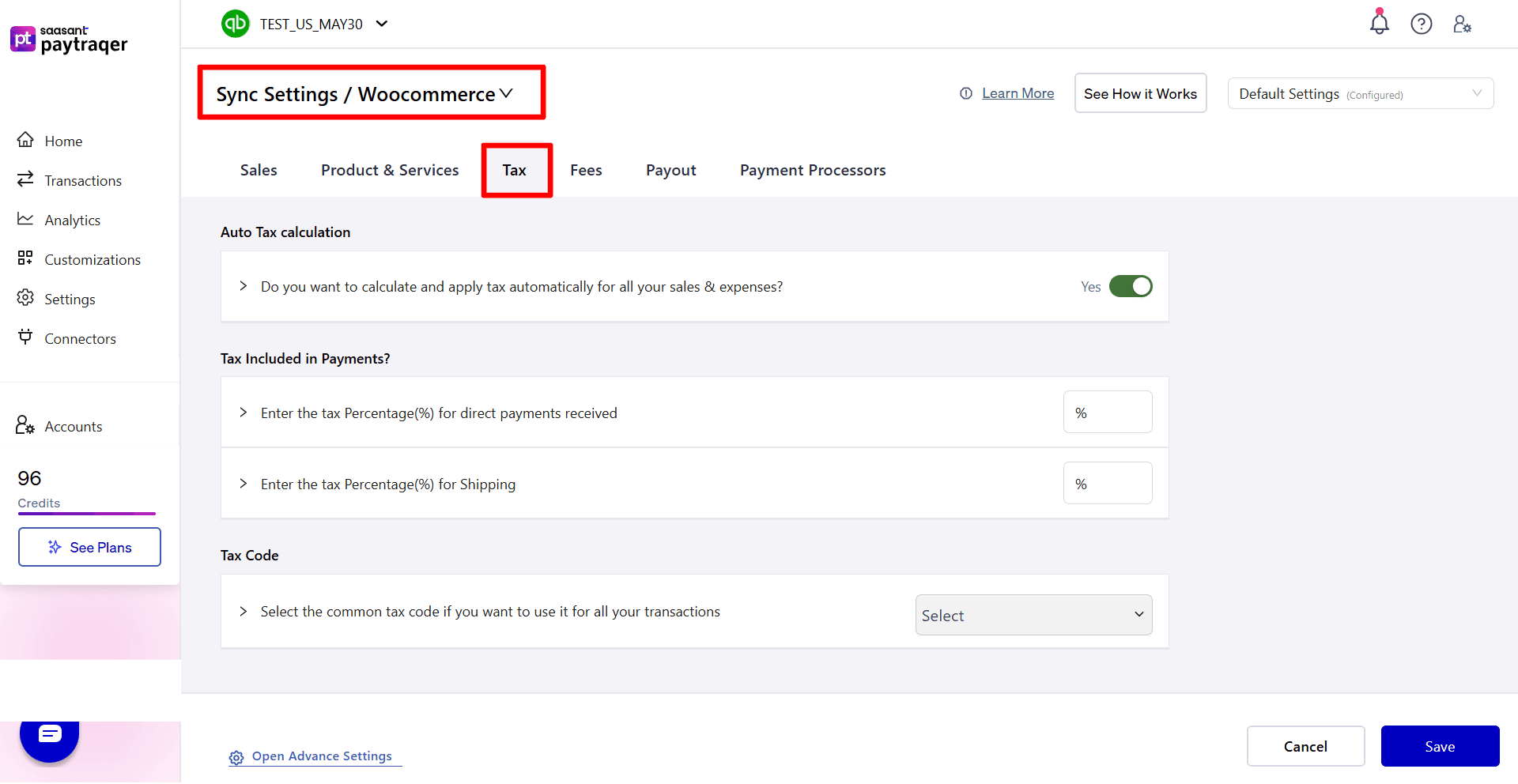
Auto Tax calculation: Yes
PayTraQer identifies and applies tax for sales and expenses.
Tax Included in Payments
Enter the Tax Percentage (%) if your payments are tax inclusive.
Shipping tax percentage
Enter the Tax Percentage (%) if shipping is taxable.
Tax Code
Choose a default tax code if you want one code for all transactions.
This overrides automatic detection.
Fee settings
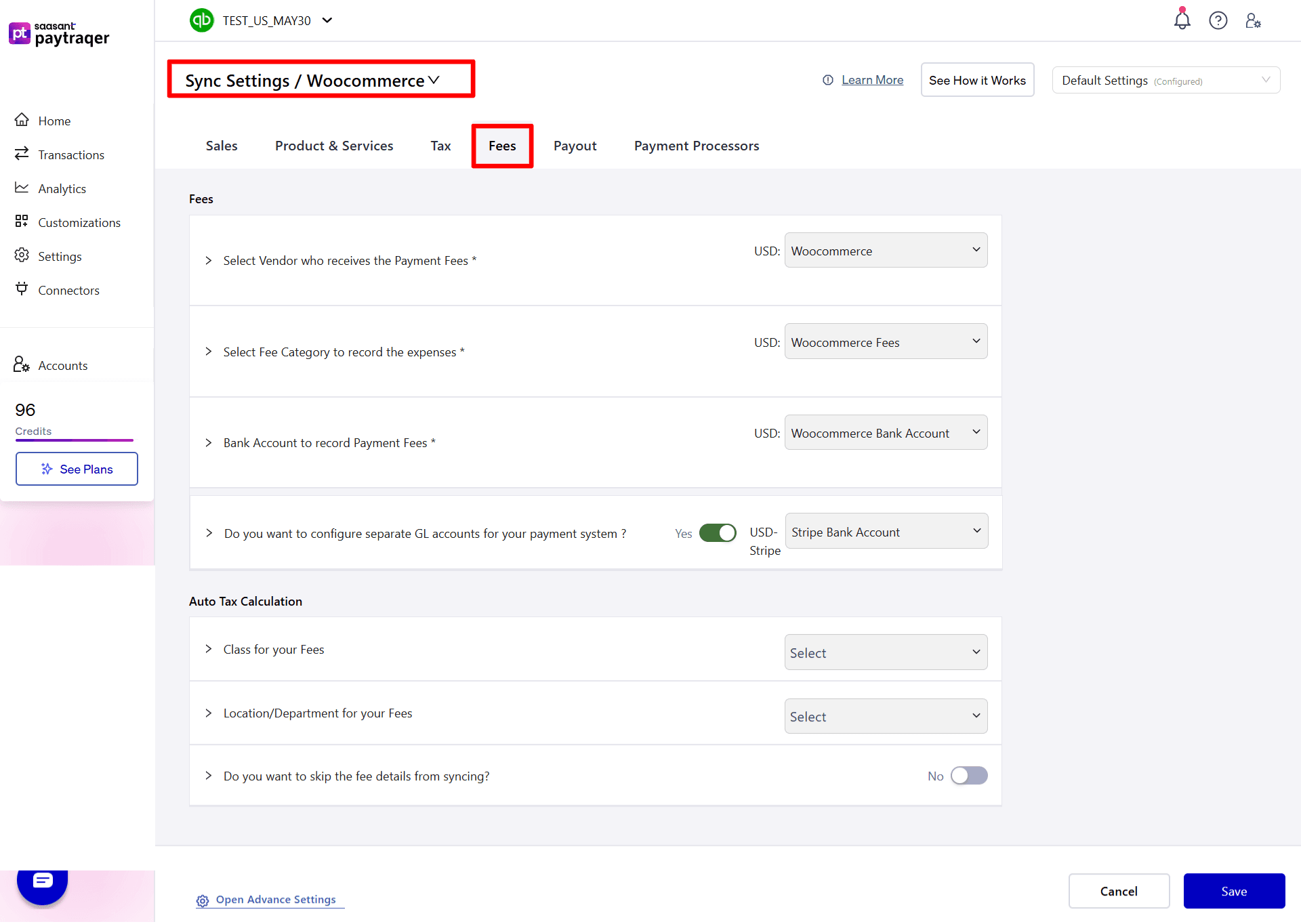
Vendor who receives the Payment Fees: WooCommerce
Fee Category to record the expenses: WooCommerce Fees (or similar expense account)
Bank Account to record Payment Fees: WooCommerce Bank Account
Configure separate GL accounts for your payment system: Yes
For example: USD – Stripe → Stripe Bank Account
This lets you route Stripe-related fees to a Stripe bank account and fee account while WooCommerce stays in its own clearing account.
Make sure your Stripe connector is linked under Payment connectors.
Class and Location/Department for your Fees
Set defaults if you track fee expenses by class or location.
Skip the fee details from syncing: No
Keep this off to record fee lines.
Payout settings
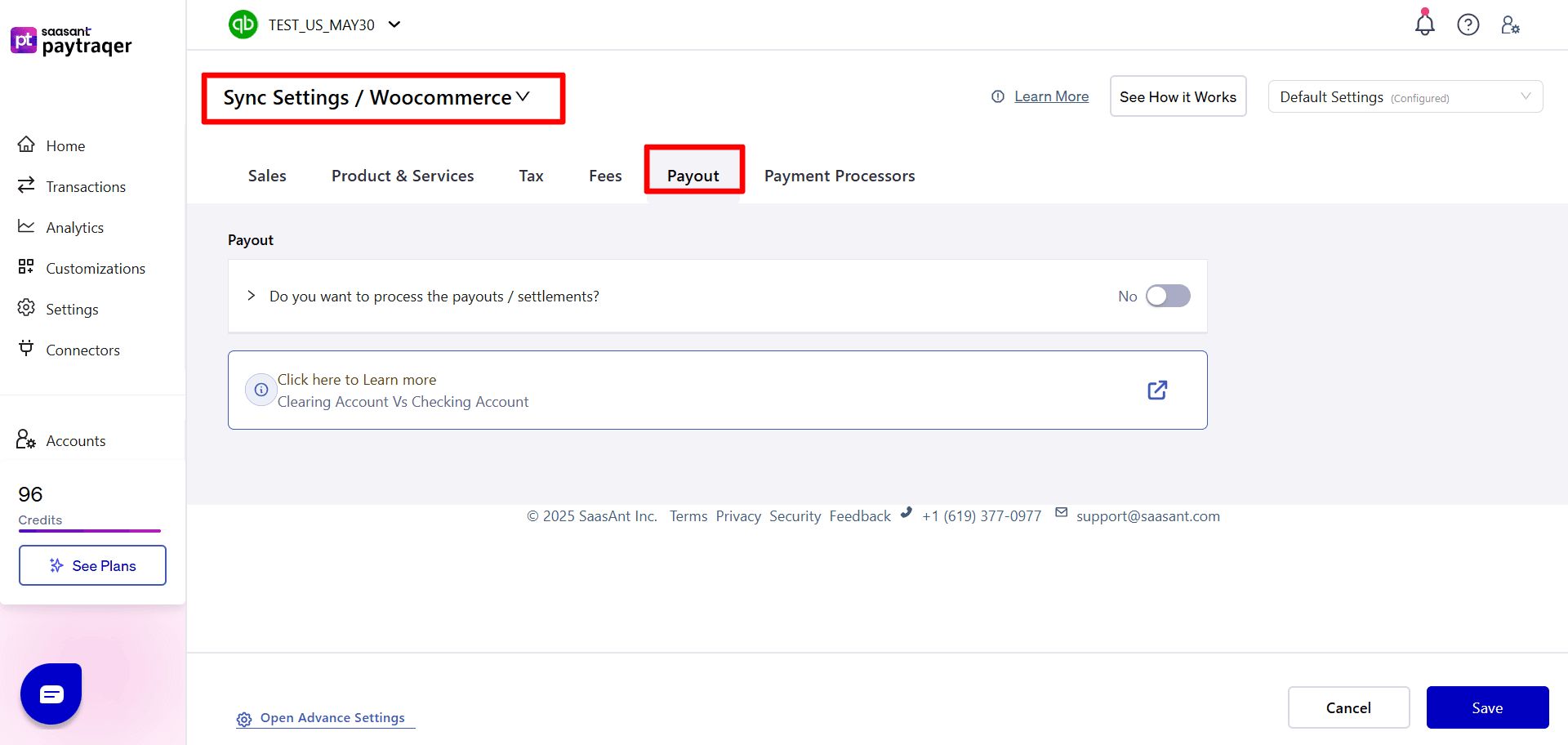
Process the payouts / settlements: No by default
Turn On to sync payouts as transfers to your checking account.
Clearing account vs checking account
Clearing account: your WooCommerce Bank Account where PayTraQer posts sales and fees.
Checking account: your actual bank account in QuickBooks.
When payouts are on, PayTraQer creates a Bank Payout or Transfer from clearing to checking so deposits match your bank feed and the clearing account nets to zero.
History and automation
Download historical transactions
After first connect, use the date filters to bring in older WooCommerce activity for cleanup or backfill.
Auto Sync
Turn on Auto Sync and set the interval so PayTraQer downloads and posts new orders and fees without manual work.
Verify your first sync
Use a small date range and check these in QuickBooks:
A sale posts to WooCommerce Bank Account with the chosen form (Invoice or Sales Receipt) and Payment Method WooCommerce.
Customers map correctly or a Common Customer is used when you chose summaries.
Items exist and map correctly, or were auto-created with the right income account.
Fee expenses post to WooCommerce Fees (or your selected account) with vendor WooCommerce or the processor.
Tax code and amount look correct on a sample sale.
If you turned on payouts, a Bank Payout or Transfer moves funds from your WooCommerce clearing account to your checking account and matches your bank feed.
Troubleshooting
No data after connect
Check WooCommerce approval, connector status, and your date range.Deposits do not match
Turn on payouts and choose your checking account as the receiving account.Clearing account does not zero
Make sure sales, fees, and payouts all use the same clearing bank.Wrong items or duplicates
Adjust Match Product by to Name or SKU and add Product Matching rules. Keep auto-create items on.Duplicate customers
Add Customer Matching rules or use a Common Customer when you post summaries.Tax looks off
Review Auto Tax, inclusive settings, shipping tax, and default tax code. Test a short date range.Only need fee entries
Turn on Skip the sales & process the associated fees only in Sales settings.
FAQs
Can I sync WooCommerce as a daily summary instead of each order
Yes. Choose Consolidated in Sync Mode or change it later in settings.
How do I use different accounts by payment method
Link processors like Stripe under Payment connectors, then enable separate GL accounts for your payment system and map each one.
Can I bring in historical WooCommerce orders
Yes. Use Download historical transactions with the desired date range.
What form should I use for WooCommerce sales
Use Sales Receipts when customers pay at checkout. Use Invoices if you issue invoices and take payment later.